Part 3 of Sarita’s travel diary: in Tilopa and Naropa’s footsteps, visiting Lamayuru and Diskit Monasteries, and the Nubra Valley
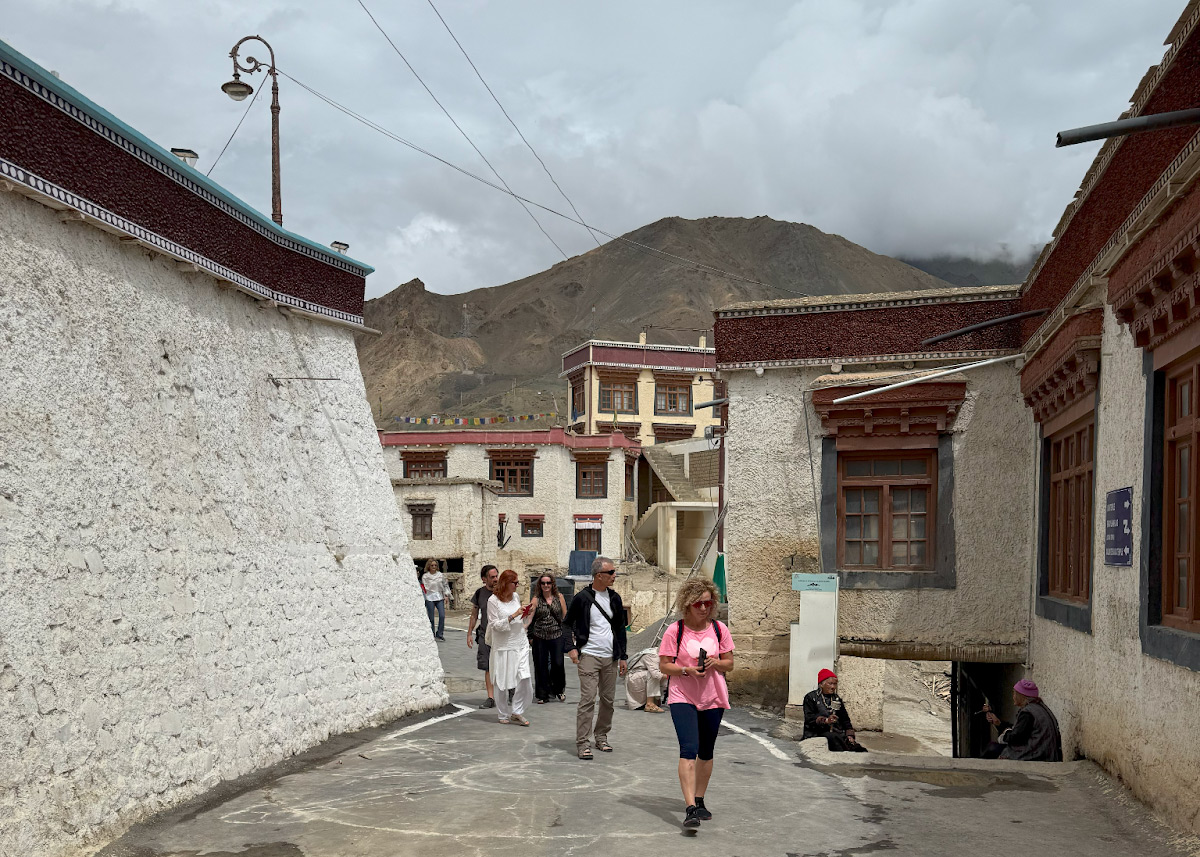
Excursions from Uleytokpo to
· Lamayuru Monastery
· Sacred Rock of the Little People
Wednesday, 16 July 2025
After a fabulous breakfast at our Lchang Nang Retreat, we set off for a one hour’s drive through Ladakh’s vast moonscape terrain to Lamayuru Monastery, one of the most revered and atmospheric gompas in the region. Lamayuru is sometimes called the ‘Eternal Monastery’. Local tradition holds that it was founded by the Indian sage Naropa in the 10th-11th century, though its roots may stretch back even earlier, into the pre-Buddhist Bon tradition. The village surrounding it is famous for its strange, eroded landscape known as the ‘Moonland’, barren yellow slopes that look otherworldly under the high-altitude sun.
The monastery is dedicated to Naropa. Born into a wealthy Kashmiri Brahmin family, Naropa received the finest education of his age. He studied at the great Nalanda University, Bihar, the intellectual heart of Buddhist India, mastering both Sutra (the philosophical and ethical discourses of the Buddha) and Tantra (the esoteric teachings that transform ordinary experience into spiritual realisation).
At Nalanda, Naropa became a celebrated scholar and debater. In those days, public debates on philosophy and religion carried real stakes. The one who lost the debate accepted discipleship under the victor. Naropa’s brilliance meant he attracted hundreds of followers. After one such debate, it is said, 600 Hindus converted to tantric Buddhism under his guidance.
One day he encountered a terrifying, dishevelled old woman, whom he later recognised as a dakini, a fierce embodiment of feminine wisdom. She asked him, “Do you understand the scriptures through knowledge or through experience?” When Naropa first replied that he had embodied their wisdom, she accused him of lying. Confronted, he admitted that his knowledge was intellectual, not experiential. The dakini was pleased with his honesty, and she instructed him to seek her brother, Tilopa, a wandering Tantric Master. The moment Naropa heard Tilopa’s name, he felt a profound resonance, as if destiny itself had spoken.
Naropa abandoned his scholarly life, wealth, and status to find Tilopa, a search that became legendary. Tilopa disguised himself in countless forms (a beggar, a fisherman, a wandering yogi), testing Naropa’s persistence. When Naropa finally found him, Tilopa did not immediately accept him but subjected him to twelve major and twelve minor trials, ordeals that shattered his pride and dissolved karmic obstacles. These trials, though brutal, sometimes involving physical danger or humiliation, purified Naropa completely. His unwavering surrender eventually led to his full awakening, and he was recognised as Tilopa’s successor.
The Six Yogas of Naropa
Among Naropa’s many contributions, his Six Yogas became foundational to Tibetan Buddhism, especially in the Kagyu lineage. These advanced tantric practices are:
- Tummo (Inner Heat) – generating subtle heat in the body through visualisation and breath, a practice still used by monks to meditate in freezing Himalayan caves wearing only thin robes.
- Illusory Body Yoga – realising that all phenomena, including one’s body, are like dreams or illusions.
- Clear Light Yoga – awakening to the pure luminosity of consciousness itself, beyond thoughts and form.
- Dream Yoga – becoming lucid within dreams, transforming the dream state into spiritual practice.
- Phowa – the conscious transference of awareness at the time of death to ensure a higher rebirth or liberation.
- Bardo Yoga – mastering the intermediate state between death and rebirth, bridging past lives and future destinies.
Together, these practices formed a map of liberation that monks and yogis have followed for centuries, a path said to lead all the way to the Rainbow Body, the dissolution of the physical form into pure light.
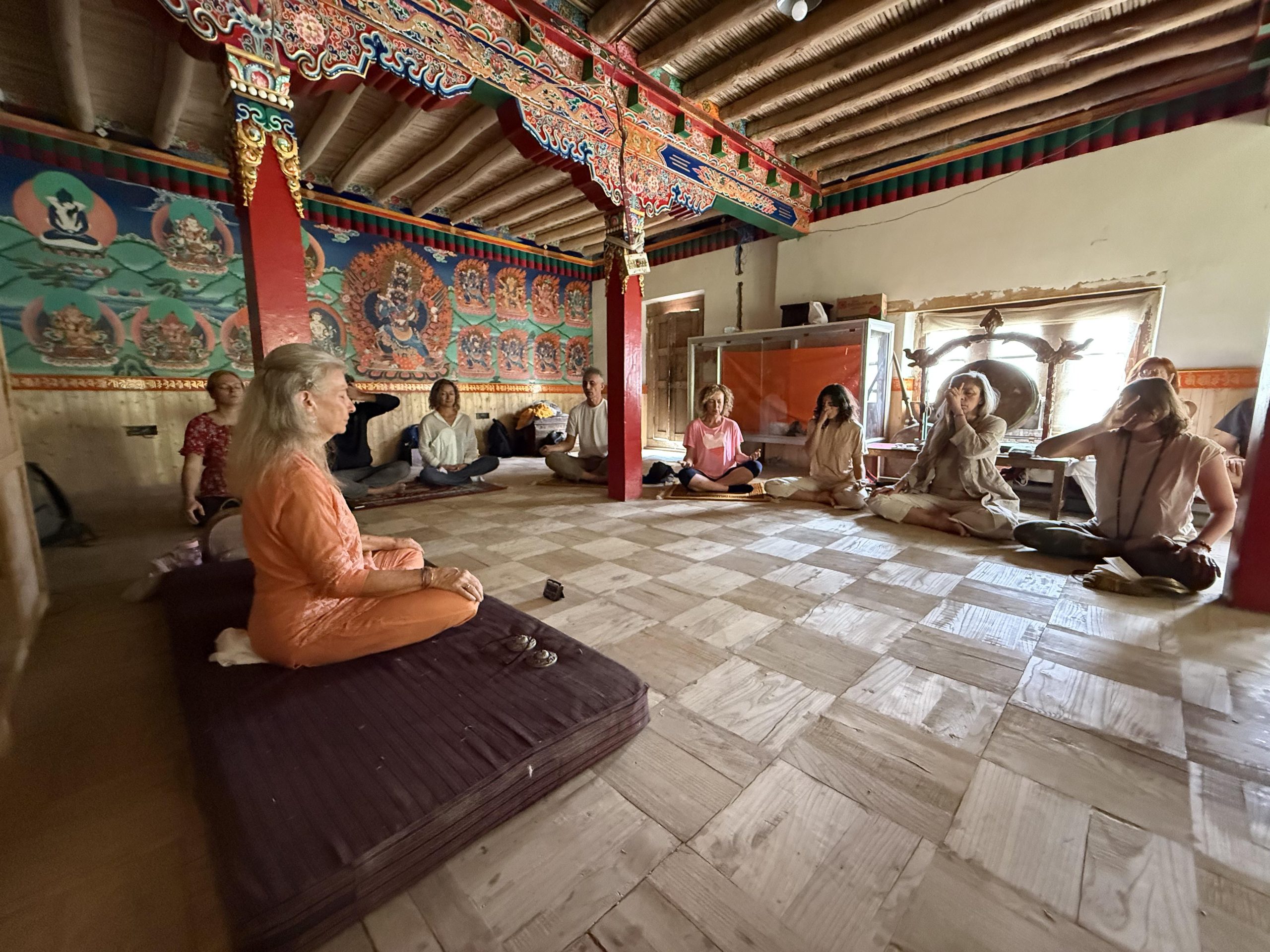
Lamayuru Monastery
When we arrived at the Monastery, we climbed up to a private room near the roof, where I led our group in the Samadhi Breath Meditation, preparing us to tune into Naropa’s frequency. After an hour of stillness, we entered the main temple, where a cave once used by Naropa is enshrined. Sitting in meditation so close to the very rock where he once practised, I felt a current of powerful energy, as if his uncompromising devotion still reverberated through the walls.
My immersion was briefly interrupted by a grumpy monk who told me off for sitting in a windowsill, seeking some quiet away from the stream of spiritual tourists. Even this became a kind of teaching, the reminder that spiritual practice unfolds amid the interruptions of life.

The Sacred Rock of the Little People
After visiting the Lamayuru Monastery, we saw a site on the bank of the Indus River that remains cloaked in mystery. A vast rock formation rising like a fortress is said to be the dwelling place of elemental beings, the so-called ‘little people’ of Ladakh. Local lore says that only highly-realised lamas can see and communicate with them. These elemental beings are considered guardians of the land, maintaining its subtle balance.
The area is now fenced off by the military, perhaps because of its strategic location, but stories persist of lamas sneaking in to commune with these beings. We found a gap in the fence and approached the sacred rock to meditate.
By midday, we returned to the resort, our personal Eden by the Indus. Lunch was a lavish feast of Himalayan flavours, followed by free hours for rest, Ayurveda massages, or simply lying in the gardens, sun on our faces and mountain air in our lungs.
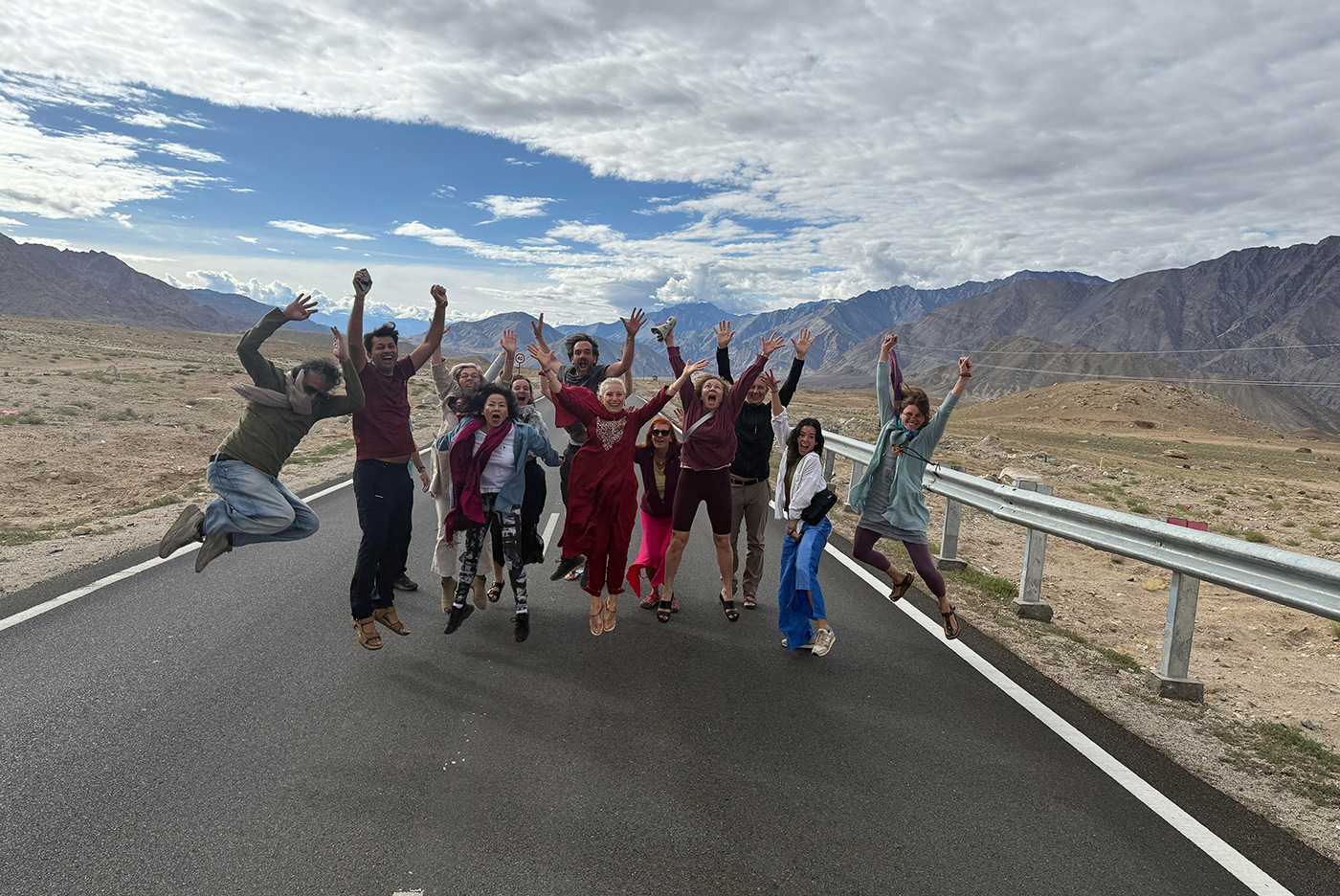
Leaving Uleytokpo for the
· Nubra Valley
via Khardung La (Pass)
Thursday, 17th July 2025
We left our resort at 6:30am, hearts heavy from saying goodbye to a staff who had cared for us like family. The manager and his team lined up at the entrance, smiling and waving until our bus disappeared from sight. Their warmth stayed with us as we braced for a six-hour drive toward the legendary Nubra Valley.
Ladakh’s roads are surprisingly well-engineered, many of them carved by the Border Roads Organisation. Despite the region’s extreme weather, they remain some of the highest and most reliable motorable routes in the world. This meant our ride was smoother than expected, giving us time to watch the stark, high-altitude desert unfold in front of us. About two hours in, we stopped for a picnic breakfast in the gardens of a friend of our host, Rahi. The spread; still-warm parathas, fruit, and spiced chai, felt especially luxurious against the raw Himalayan backdrop.
From there our coach climbed toward Khardung La, once known as the highest motorable pass on Earth at 5,359 meters (17,582 ft). Even though newer surveys now give that record to other passes, Khardung La remains an extraordinary crossing. Historically, it was a critical artery of the ancient Silk Road, where traders carried silk, tea, and spices on camelback between Leh and the markets of Central Asia.

Once in Nubra, the landscape shifted dramatically. Wide and fertile, fed by the confluence of the Shyok and Siachen Rivers, the valley has long been called Ldumra, “the valley of flowers.” For centuries it remained sealed off for much of the year, accessible only during the summer months when snowmelt opened the passes.
This isolation preserved its sense of purity, giving visitors today the feeling of stepping into a place less touched by modernity. Around us, sheer mountains shimmered in tones of rust, gold, and violet as the sun moved, while above, an impossibly blue sky framed wandering white clouds like brushstrokes on a canvas.
Our eco-hotel, Lchang Nang Retreat, welcomed us with quiet elegance. Run by relatives of the Dalai Lama, the retreat embodies Ladakhi traditions of simplicity and respect for the land with solar power, mud-brick cottages, and meals sourced from local farmers.
Later, we headed to the famous white sand dunes of Hunder, where the unlikely sight of double-humped Bactrian camels awaited us. These camels are living relics of Silk Road caravans; legend has it that some strayed and remained here when Panamik village was a key resting post along the route. Their descendants now graze in the valley, offering rides that evoke the romance of bygone traders.
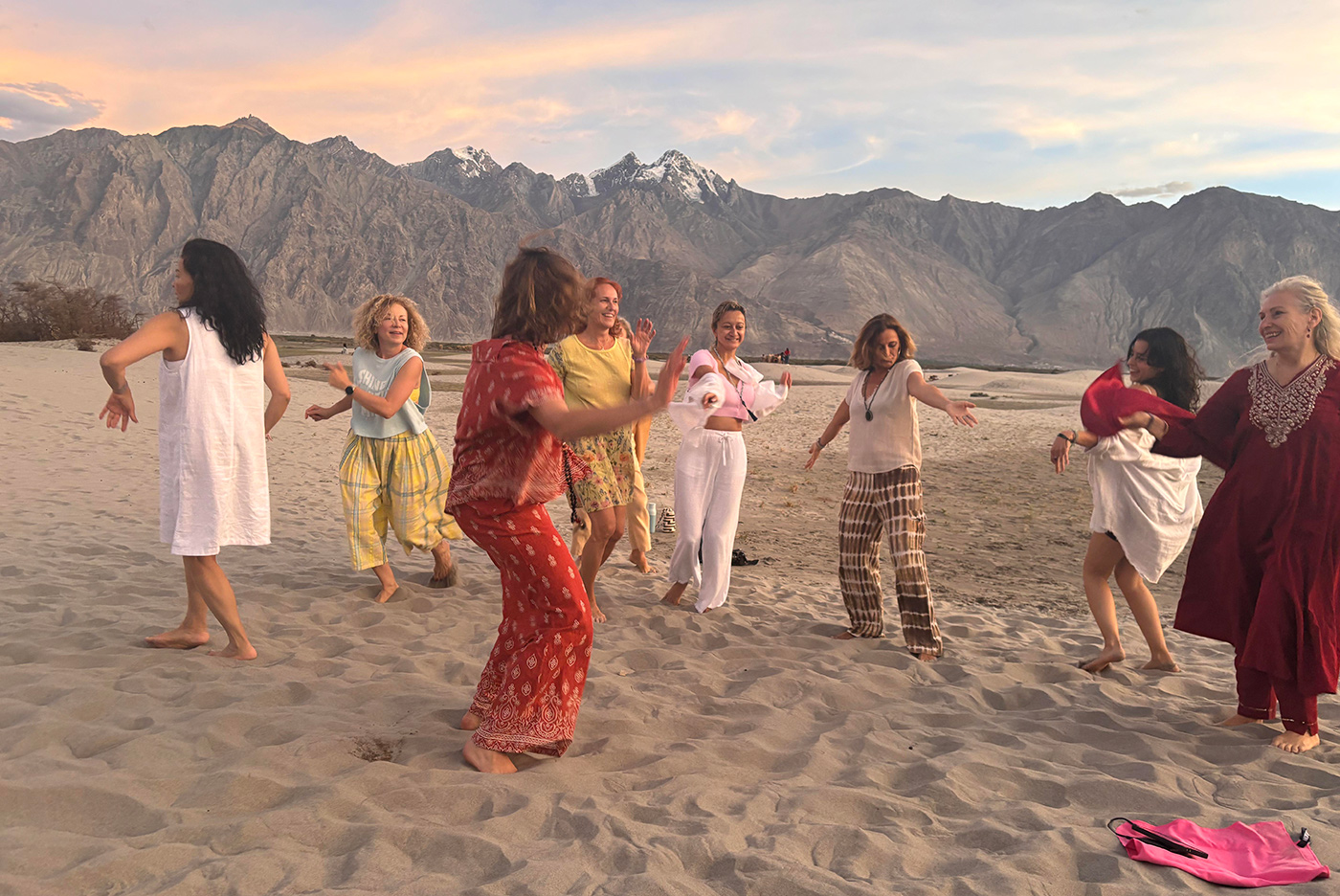
Our group couldn’t resist the playfulness of the setting. Some rode camels, others chased the golden light with cameras. As the sun sank, painting the mountains in soft pink hues, something shifted, laughter spilled out, a few began to dance barefoot in the dunes, and joy overtook self-consciousness.
The Nubra Valley is working its magic…
Excursions in the Nubra Valley to
· Panamik Hot Springs
· Diskit Monastery
· Maitreya Buddha
Friday, 18 July 2025
What a delight it was to rise before dawn and make our way to the Panamik sulphur hot springs, famed across Ladakh for their mineral-rich waters. At 10,500 feet, Panamik lies along the old Silk Road, where weary traders once stopped to rest themselves and their camels. The hot water here gushes almost boiling straight from fissures in the mountainside, cooled as it is channelled into descending pools of different temperatures. Rich in sulphur, calcium, and magnesium, these springs are believed to soothe arthritis, skin ailments, and muscle fatigue. Even the Indian Army maintains pools here for soldiers stationed along the frigid Siachen Glacier.
Soaking in the steaming pools as the crisp morning air bit our cheeks, we gazed out at snow-clad peaks. It was a paradox of fire and ice, our bodies held in liquid heat while our breath formed visible clouds in the cold dawn. Local custom dictated that women enter covered in T-shirts while men bathed bare-chested, a rule that felt unnecessarily modest given the medicinal purpose of the springs. Yet such cultural codes, however puzzling, are part of travel; they remind us that sacred places are lived differently by each community.

From the springs we set off on a short trek over a rocky ridge to a hidden lake revered as sacred by villagers. The lake has no visible inlet or outlet, yet remains full year-round, a phenomenon that inspires both geological curiosity and spiritual reverence. Local lore holds that its waters are blessed, and that meditating here magnifies one’s prayers. The silence was profound, broken only by the wind skimming the surface and the occasional call of a Himalayan magpie. We settled into stillness, some circling the lake in walking meditation, others resting in shaded nooks until our picnic breakfast arrived.
Diskit Monastery
In the afternoon, we visited Diskit Monastery, the oldest and largest in Nubra, founded in the 14th century by Changzem Tserab Zangpo, a disciple of Tsongkhapa, founder of the Gelugpa order of Tibetan Buddhism. Perched on a rocky hill, Diskit once stood watch over the caravan routes that wound through Nubra toward Central Asia. Inside, we were greeted by flickering butter lamps and the heady smell of juniper incense. Ancient murals of guardian deities covered the walls, their fierce faces painted to ward off misfortune.
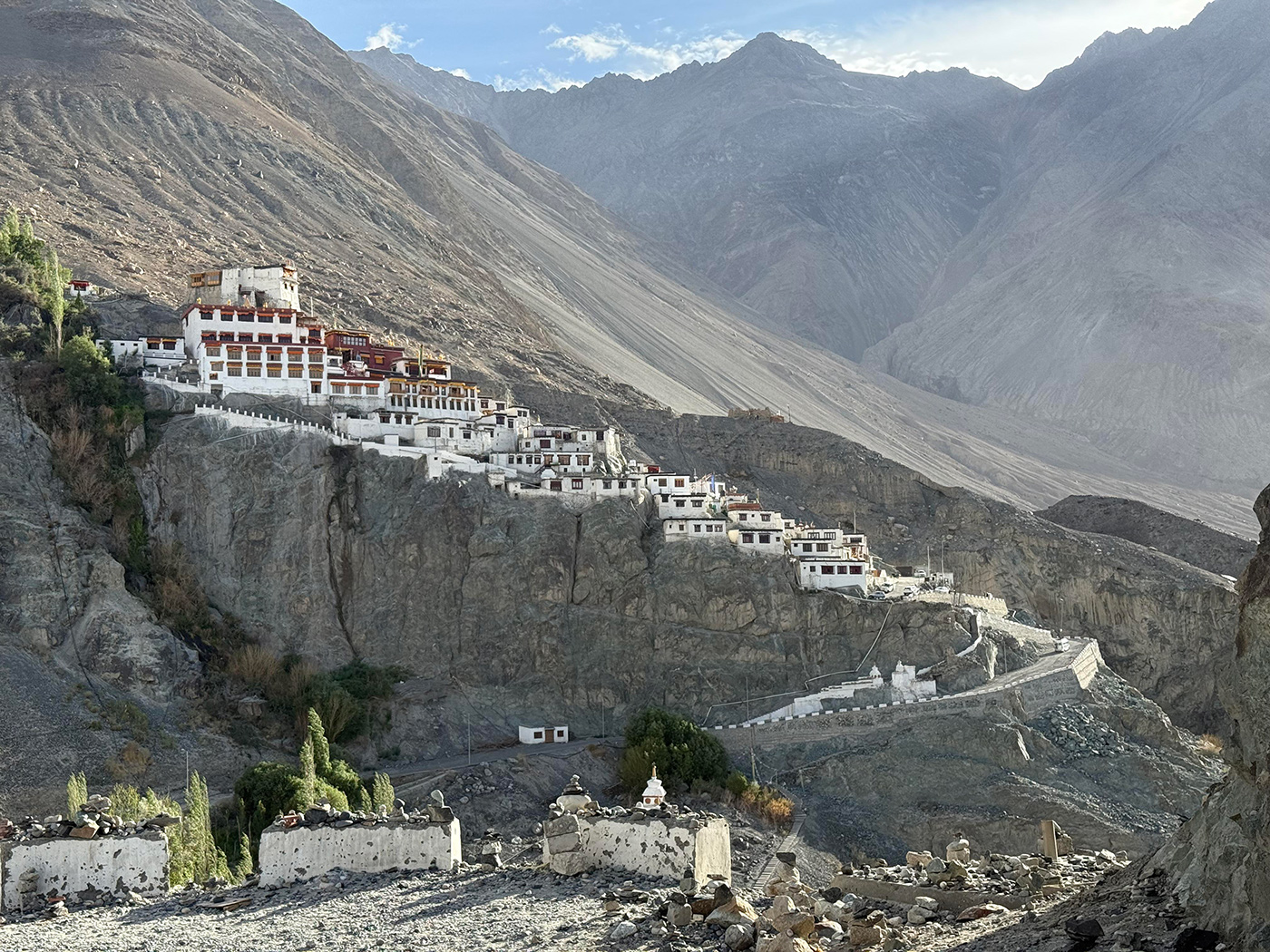
A particularly strange relic drew our attention: a statue of the goddess Kali clutching the severed head and hand of a Mongol marauder. According to legend, this man attempted to loot the monastery centuries ago but was slain in the act. The tale embarrassed Mongol rulers so deeply that they sent lavish gifts of silk and gold in apology, transforming an act of violence into a bridge of diplomacy.
Another chamber contained a humble room where the Dalai Lama once stayed during his visits. Its walls are lined with photographs of him as a young man, reminders of the monastery’s continuing ties to Tibet’s spiritual lineage.
Maitreya Buddha statue
Just below the monastery, we approached the colossal 32-meter Maitreya Buddha statue, consecrated in 2010 by the Dalai Lama himself. Facing the Shyok River and Pakistan beyond, the statue was built both to promote world peace and to serve as a spiritual protector for Diskit and the Nubra Valley. Draped in robes painted pink and green, the hues of the heart chakra, its golden face glowed in the last rays of sunset. Seeing it shimmer against a backdrop of indigo mountains, it felt less like a statue and more like a living presence watching over the valley.

By evening, we returned to our resort, our bodies still humming with the day’s impressions. After dinner, the staff surprised us by setting up an open-air theatre beneath a starlit sky. Wrapped in shawls, we watched Bertolucci’s film, The Little Buddha with Keenu Reeves, its scenes of Himalayan landscapes eerily mirroring the majesty surrounding us.
To be continued…
Photographs by Rahi, Danelle and participants





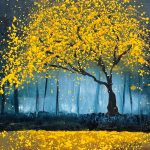
Comments are closed.